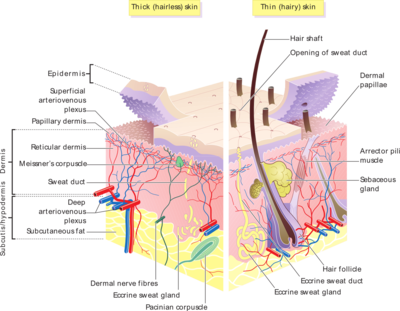Skin gland
A skin gland, or dermal gland , anatomically called the glandula cutis , is a gland that lies in the outer skin .
In its simplest form, a skin gland is formed by a single cell , which differs from the other skin cells in terms of its content, usually also in terms of its shape, and empties its secretion through an opening to the outside. Skin glands occur as single or multicellular glands in the integument of many multicellular animals (Metazoa). Phylogenetically , they are transformed epidermal cells . In some species , contiguous epidermal gland plates are formed or complex gland conglomerates reaching into the subcutaneous tissue, which are connected to the epidermis via individual ducts.
Mucus- forming skin cells and goblet cells are common in vertebrates and invertebrates . They primarily serve to mechanically protect the integument, make the surface of the organism more slippery and reduce frictional forces , for example in the case of vortex worms , gnathostomulida , molluscs , polychaeta , enteropneusten and in aquatic vertebrates such as fish and amphibians. Poison glands in amphibians or fluorescent glands in fish are derived from these glands. In invertebrates , too, there is an evolutionary differentiation of glandular organs in the exoskeleton , for example as glue glands in gastrotricha , rotifers , camptozoa and insects . Furthermore, special cuticle glands are known, such as spinnerets in the spinning apparatus of arachnids or poison glands, oil glands, wax glands and lacquer glands in arthropods .
In mammals, the mammary gland is the largest skin gland. Their sebum glands , scent glands and sweat glands are smaller .

Forms of formation of the skin glands in mammals
- The eccrine sweat gland , Glandula sudorifera merocrina, refers to a gland in the dermis ( corium ) that lies below the upper skin ( epidermis ). It produced the sweat , sudor, which is excreted through a pore in the epidermis; it mainly serves to regulate the heat balance .
- The sebum gland , Glandula sebacea, is a lipid- producing, holocrine gland in the upper part of the dermis, the stratum superficiale dermidis . The lipids produced are known as sebum or sebum . The sebum glands are mainly located on the epithelium of the hair systems ; therefore also hair follicle glands. Other sebum glands, the so-called free sebum glands, are mainly located in the nostrils, the red lips and in the genital area.
- The apocrine sweat glands or scent glands , Glandula sudorifera apocrina , in addition to pheromone - like scents, release other substances into the hair funnel , which are only converted into various odorous substances together with the sebum and under the action of skin bacteria . Unlike the so-called "eccrine sweat glands", scent glands are each bound to a hair follicle and restricted to certain parts of the body. Their secretion and that of the sebum glands as well as the respective bacterial flora of a skin region are largely responsible for the (natural) body odor. Due to different scent gland secretions, body regions can have different odor characteristics. Therefore, scent glands often play a not insignificant role in social and sexual behavior; they can also be used to mark areas.
- In the female mammals, the mammary gland , glandula mammaria, is the name given to the organs responsible for secreting milk ( lactation ) and thus for nourishing the offspring. These are specialized skin glands.
Individual evidence
- ↑ Detlev Drenckhahn, Wolfgang Zenker: Benninghoff Anatomie Volume 2. 15th edition. Urban & Schwarzenberg, Munich / Vienna / Baltimore 1993, ISBN 3-541-00255-7 , p. 809.
